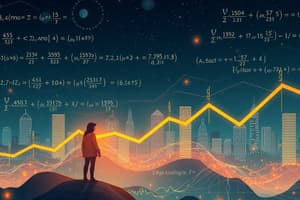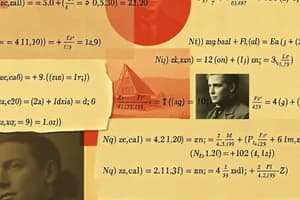Podcast
Questions and Answers
What is the formula for the Labor Participation Rate?
What is the formula for the Labor Participation Rate?
- Unemployed / Labor force
- Employed / Population
- Unemployed + Employed / Population (correct)
- Labor force / Population
What is the Unemployment Rate formula?
What is the Unemployment Rate formula?
Unemployed / Labor force
What is the Spending Multiplier?
What is the Spending Multiplier?
1/MPS
What is the Tax Multiplier?
What is the Tax Multiplier?
What is the Money Multiplier?
What is the Money Multiplier?
What is the Real Interest Rate?
What is the Real Interest Rate?
What happens to the equilibrium price when demand increases?
What happens to the equilibrium price when demand increases?
What is the effect of an increase in supply on the equilibrium price?
What is the effect of an increase in supply on the equilibrium price?
What does consumer spending increase lead to?
What does consumer spending increase lead to?
What happens to investment when interest rates increase?
What happens to investment when interest rates increase?
What is the result of an increase in inflation?
What is the result of an increase in inflation?
What effect does an increase in aggregate demand have on the price level?
What effect does an increase in aggregate demand have on the price level?
What happens to the price level when SR aggregate supply increases?
What happens to the price level when SR aggregate supply increases?
What is the impact of increasing government spending on Real GDP?
What is the impact of increasing government spending on Real GDP?
What effect does an increase in taxes have on disposable income?
What effect does an increase in taxes have on disposable income?
What does an increase in MPC do to the spending multiplier?
What does an increase in MPC do to the spending multiplier?
What happens to bond prices when interest rates increase?
What happens to bond prices when interest rates increase?
What occurs to nominal interest rates when the money supply increases?
What occurs to nominal interest rates when the money supply increases?
What happens to the money supply when reserve requirements increase?
What happens to the money supply when reserve requirements increase?
What is the relationship between discount rates and the money supply?
What is the relationship between discount rates and the money supply?
What is the effect of the Fed buying bonds on the money supply?
What is the effect of the Fed buying bonds on the money supply?
What is the result of increasing inflation on real interest rates?
What is the result of increasing inflation on real interest rates?
What does deficit spending increase lead to regarding real interest rates?
What does deficit spending increase lead to regarding real interest rates?
What is the consequence of an increase in capital stock?
What is the consequence of an increase in capital stock?
What effect does appreciation have on net exports?
What effect does appreciation have on net exports?
What happens to net capital inflow when interest rates increase?
What happens to net capital inflow when interest rates increase?
Define comparative advantage.
Define comparative advantage.
What does investment refer to?
What does investment refer to?
What defines full employment?
What defines full employment?
What is Long-Run Self-Adjustment?
What is Long-Run Self-Adjustment?
What is fiscal policy?
What is fiscal policy?
What is monetary policy?
What is monetary policy?
What are open market operations?
What are open market operations?
Define crowding out.
Define crowding out.
What is capital inflow?
What is capital inflow?
What does the Production Possibilities Curve represent?
What does the Production Possibilities Curve represent?
What is the relationship between supply and demand?
What is the relationship between supply and demand?
What changes aggregate demand?
What changes aggregate demand?
What changes aggregate supply?
What changes aggregate supply?
Flashcards
Labor Participation Rate
Labor Participation Rate
The ratio of unemployed and employed individuals to the total population. It indicates the proportion of the population that is actively participating in the workforce.
Unemployment Rate
Unemployment Rate
The percentage of the labor force that is unemployed. It reflects the number of people who are actively seeking work but unable to find it.
Spending Multiplier
Spending Multiplier
The amount by which overall demand increases for every $1 increase in spending. It's calculated as 1 divided by the Marginal Propensity to Save (MPS).
Tax Multiplier
Tax Multiplier
Signup and view all the flashcards
Money Multiplier
Money Multiplier
Signup and view all the flashcards
Real Interest Rate
Real Interest Rate
Signup and view all the flashcards
Demand Increases
Demand Increases
Signup and view all the flashcards
Supply Increases
Supply Increases
Signup and view all the flashcards
Consumer Spending Increases
Consumer Spending Increases
Signup and view all the flashcards
Interest Rates Increase
Interest Rates Increase
Signup and view all the flashcards
Inflation Increases
Inflation Increases
Signup and view all the flashcards
Aggregate Demand Increases
Aggregate Demand Increases
Signup and view all the flashcards
SR Aggregate Supply Increases
SR Aggregate Supply Increases
Signup and view all the flashcards
Government Spending Increases
Government Spending Increases
Signup and view all the flashcards
Taxes Increase
Taxes Increase
Signup and view all the flashcards
MPC Increases
MPC Increases
Signup and view all the flashcards
Interest Rates Increase
Interest Rates Increase
Signup and view all the flashcards
Money Supply Increases
Money Supply Increases
Signup and view all the flashcards
Reserve Requirement Increases
Reserve Requirement Increases
Signup and view all the flashcards
Discount Rate Increases
Discount Rate Increases
Signup and view all the flashcards
Fed Buys Bonds
Fed Buys Bonds
Signup and view all the flashcards
Inflation Increases
Inflation Increases
Signup and view all the flashcards
Deficit Spending Increases
Deficit Spending Increases
Signup and view all the flashcards
Capital Stock Increases
Capital Stock Increases
Signup and view all the flashcards
Appreciation Increases
Appreciation Increases
Signup and view all the flashcards
Interest Rates Increase
Interest Rates Increase
Signup and view all the flashcards
Comparative Advantage
Comparative Advantage
Signup and view all the flashcards
Full Employment
Full Employment
Signup and view all the flashcards
Long-Run Self-Adjustment
Long-Run Self-Adjustment
Signup and view all the flashcards
Fiscal Policy
Fiscal Policy
Signup and view all the flashcards
Monetary Policy
Monetary Policy
Signup and view all the flashcards
Open Market Operations
Open Market Operations
Signup and view all the flashcards
Crowding Out
Crowding Out
Signup and view all the flashcards
Capital Inflow
Capital Inflow
Signup and view all the flashcards
Study Notes
Formulas
- Labor Participation Rate: Calculated as (Unemployed + Employed) / Population, measures the active workforce in an economy.
- Unemployment Rate: Defined as Unemployed / Labor Force, indicates the percentage of the labor force that is not employed.
- Spending Multiplier: Given by the formula 1/MPS (Marginal Propensity to Save), highlights the effect of spending changes on overall demand.
- Tax Multiplier: Calculated as -MPC/MPS (Marginal Propensity to Consume and Save), reflects the impact of tax changes on aggregate demand.
- Money Multiplier: Expressed as 1/reserve requirement, shows how much the money supply can grow with bank reserves.
Key Economic Rates
- Real Interest Rate: The nominal interest rate adjusted for inflation, calculated as Nominal Interest Rate - Inflation Rate, affecting the true cost of borrowing.
Key Relationships in Economics
- Demand Increases: Results in an increase in equilibrium price, affecting market prices and purchasing power.
- Supply Increases: Leads to a decrease in equilibrium price, influencing consumer behavior and inventory levels.
- Consumer Spending Increases: Associated with real GDP growth, indicating a healthy economic environment.
- Interest Rates Increase: Generally results in decreased investment as borrowing costs rise.
- Inflation Increases: Corresponds with decreasing real wages, affecting consumers' purchasing power and living standards.
- Aggregate Demand Increases: Causes price levels to rise, indicating a shift in economic dynamics.
- SR Aggregate Supply Increases: Results in a decrease in price levels, indicating more goods and services available in the economy.
- Government Spending Increases: Drives a corresponding rise in real GDP, stimulating economic activity.
Effects of Changes
- Taxes Increase: Leads to a decrease in disposable income, impacting consumer spending negatively.
- MPC Increases: Results in a higher spending multiplier, indicating a stronger response to changes in income.
- Interest Rates Increase: Generally leads to a decrease in bond prices, reflecting the inverse relationship between interest rates and bond values.
- Money Supply Increases: Typically causes nominal interest rates to decrease, stimulating borrowing and spending.
- Reserve Requirement Increases: Results in a decrease in the money supply, restricting lending capabilities of banks.
- Discount Rate Increases: Also leads to a decrease in the money supply, affecting economic liquidity.
- Fed Buys Bonds: Increases money supply, encouraging circulation and investment in the economy.
- Inflation Increases: Corresponds with decreasing real interest rates, which can stimulate borrowing.
- Deficit Spending Increases: Leads to higher real interest rates due to crowding out effects on private investment.
Economic Growth and International Trade
- Capital Stock Increases: Contributes to economic growth, enhancing productivity and output.
- Appreciation Increases: Results in a decrease in net exports, affecting trade balances.
- Interest Rates Increase: Attracts net capital inflow, influencing currency values and investment patterns.
- Comparative Advantage: Defined as a country's ability to produce a good at a lower opportunity cost than another, promoting trade benefits.
Employment and Economic Policies
- Full Employment: Occurs when only frictional or structural unemployment exists, with no cyclical unemployment present.
- Long-Run Self-Adjustment: Describes how the SRAS (Short-run Aggregate Supply) adjusts to close positive or negative output gaps over time.
- Fiscal Policy: Involves altering government spending and/or taxes, shifting aggregate demand to influence economic performance.
- Monetary Policy: Entails changing the money supply to impact interest rates, also shifting aggregate demand.
- Open Market Operations: The central bank's activity of buying or selling bonds to regulate the money supply.
Supply and Demand Dynamics
- Crowding Out: Refers to how deficit spending can increase interest rates, reducing private investment.
- Capital Inflow: High-interest rates can deter domestic investment but attract foreign financial capital, influencing market dynamics.
Other Economic Concepts
- Production Possibilities Curve: Represents the potential output combinations for two goods and the trade-offs involved.
- Loanable Funds: The market for borrowing and lending, where savings and investments interplay.
- Phillips Curve: Illustrates the inverse relationship between inflation and unemployment rates.
- Foreign Exchange: The market for currencies, influencing international trade and economic relations.
Factors Influencing Aggregate Demand and Supply
- Aggregate Demand Changes: Driven by exports, consumption, investment, and government spending (ECIG).
- Aggregate Supply Changes: Affected by labor, technology, wages, production costs, and inflation dynamics.
Studying That Suits You
Use AI to generate personalized quizzes and flashcards to suit your learning preferences.




